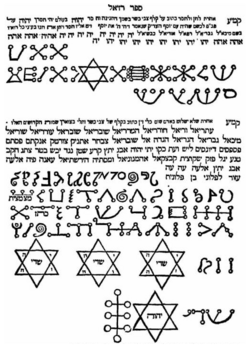Sefer Raziel HaMalakh
Topic: Unsolved
 From HandWiki - Reading time: 4 min
From HandWiki - Reading time: 4 min
Sefer Raziel HaMalakh (Hebrew: ספר רזיאל המלאך, "the book of Raziel the angel") is a grimoire of Practical Kabbalah from the Middle Ages written primarily in Hebrew and Aramaic. Liber Razielis Archangeli, its 13th-century Latin translation produced under Alfonso X of Castile, survives.
Textual history
Like other obscure ancient texts such as the Bahir and Sefer Yetzirah, Sefer HaRaziel has been extant in a number of versions. The book cannot be shown to predate the 13th century, but may in parts date back to late antiquity insofar as its title is mentioned in another magical work of late antiquity: The Sword of Moses.
The book claims to have been revealed to Adam by the angel Raziel. Critical historians regard it as a medieval work, most probably originating among the Ashkenazi Hasidim, as citations reliant on the main body content of the work as we receive it begin to appear only in the 12th century. At least one section was available to Ibn Ezra before 1153, when he finished his commentary to Exodus.[1] The likely compiler of the medieval version is Eleazar of Worms, as Sefer Galei Razia, which developed into what we have now as Sefer Raziel, including more writings written by people of various theological opinions.[2] According to Jacob Emden, it was compiled by Abraham Abulafia.
Contents
It draws heavily on Sefer Yetzirah and Sefer HaRazim "Book of Secrets". There are multiple manuscript versions, containing up to seven tractates. The printed version of Sefer Raziel is divided into five books, some of it in the form of a mystical midrash on Creation. It features an elaborate angelology, magical uses of the zodiac, gematria, names of God, protective spells, and a method of writing magical healing amulets.
Book six of the Liber Razielis is based on Sefer haRazim, with various additions, including the "Prayer of Adam" of Sefer Adam.
The book became notorious in German Renaissance magic, named together with Picatrix as among the most abominable works of necromancy by Johannes Hartlieb. The prayer of Adam is paraphrased by Nicholas of Cusa in two sermons (Sermo I, 4, 16.25; Sermo XX, 8, 10-13) and further made use of by Johann Reuchlin in his De Arte Cabbalistica.[3] Konrad Bollstatter in the 15th century also shows awareness of the Latin version of the "Prayer of Adam" an interpolation in Cgm 252, although he replaces Raziel with Raphael and Seth with Sem.[4]
Tree of Knowledge
Adam, in his prayer to God, apologized for listening to his wife Eve, who was deceived by the snake into eating from the Tree of Knowledge. According to the Book of Raziel, God sent the highest of the angels, Raziel, to teach Adam the spiritual laws of nature and life on Earth, including the knowledge of the planets, stars and the spiritual laws of creation.
The angel Raziel also taught Adam the knowledge of the power of speech, the power of thoughts and the power of a person's soul within the confines of the physical body and this physical world, basically teaching the knowledge with which one can harmonize physical and spiritual existence in this physical world.
The angel Raziel teaches the power of speech, the energy contained within the 22 letters of the Hebrew alphabet, their combinations and meanings of names.
Adam and Abraham
According to Jewish traditions, the angel Raziel was sent to Earth to teach Adam, and due to the elevated soul of Abraham, Raziel returned to teach Abraham all the spiritual knowledge and spiritual laws. Raziel was sent to Earth to teach Adam and Abraham the ways of Nature. The Book of Raziel explains everything from astrology to how the creative life energy starts with a thought from the spiritual realms, prior to manifestation as speech and action in this physical world. The eternal divine creative life energy of this earth is love, the book explains the spiritual laws of birth, death, reincarnation of the soul, and many spiritual laws of "change".
Heptameron
The Heptameron, ascribed to Petrus de Apono, is based on the Book of Raziel.[5]
Editions
- רזיאל המלאך. Amsterdam (1701) Chabad-Lubavitch Library. Full-text PDF version, in Hebrew, from HebrewBooks.org
- Steve Savedow (trans.), Sepher Rezial Hemelach: The Book of the Angel Rezial, Red Wheel/Weiser (2000), ISBN:978-1-57863-193-3.
- The Book of the Angel Raziel. Volume I / Transl. from Hebrew and Aramaic and comm. by E. V. Kuzmin; editorship and foreword by B. K. Dvinyaninov. — St. Petersburg: Academy Of Culture's Research, 2020. — 264 pp.: illustrated, — (Code Grimoire Series). ISBN:978-5-6045100-3-2 (на русском языке)
- The Book of the Angel Raziel. Volume II / Transl. from Hebrew and Aramaic, afterword and comm. by E. V. Kuzmin; editorship and foreword by B. K. Dvinyaninov. — St. Petersburg: Academy Of Culture’s Research, 2021. — 512 pp.: illustrated, — (Code Grimoire Series). ISBN:978-5-6045100-4-9 (на русском языке)
See also
- Hebrew astronomy
- Jewish astrology
- Jewish views on astrology
- Primary texts of Kabbalah
- Semiphoras and Schemhamphorash
- Bahir
- Sefer HaRazim
References
- ↑ See Abraham Ibn Ezra on Exodus 14:19
- ↑ admin (2019-01-29). "On the Origins and Authenticity of Zohar" (in en-US). https://jewishbelief.com/on-the-origins-and-authenticity-of-zohar/.
- ↑ Wilhelm Schmidt-Biggemann, Reuchlin-Tagung Pforzheim 2001
- ↑ Cgm 252, f. 142r-144r; Encyclopaedia Judaica 1, 777
- ↑ "Peter of Abano: Heptameron, or Magical Elements". http://www.esotericarchives.com/solomon/heptamer.htm.
Further reading
- Avilés, A.G., Alfonso X y el Liber Razielis: imágenes de la magia astral judía en el scriptorium alfonsí, Bulletin of Hispanic Studies, Volume 74, Number 1, 1 January 1997, pp. 21–39
External links
- The Original ספר "Sefer" Book of Raziel ספר רזיאל המלאך The Amsterdam Edition of Sefer Raziel "Book of Raziel" ספר רזיאל המלאך
- The english translation of the book on Internet Archives
 |
 KSF
KSF
